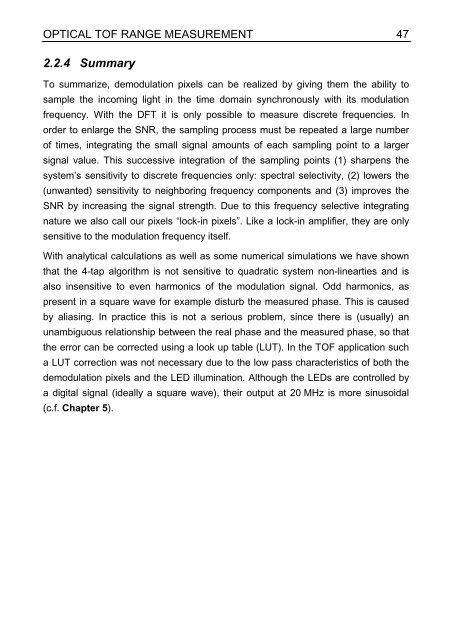3D Time-of-flight distance measurement with custom - Universität ...
3D Time-of-flight distance measurement with custom - Universität ...
3D Time-of-flight distance measurement with custom - Universität ...
You also want an ePaper? Increase the reach of your titles
YUMPU automatically turns print PDFs into web optimized ePapers that Google loves.
OPTICAL TOF RANGE MEASUREMENT 47<br />
2.2.4 Summary<br />
To summarize, demodulation pixels can be realized by giving them the ability to<br />
sample the incoming light in the time domain synchronously <strong>with</strong> its modulation<br />
frequency. With the DFT it is only possible to measure discrete frequencies. In<br />
order to enlarge the SNR, the sampling process must be repeated a large number<br />
<strong>of</strong> times, integrating the small signal amounts <strong>of</strong> each sampling point to a larger<br />
signal value. This successive integration <strong>of</strong> the sampling points (1) sharpens the<br />
system’s sensitivity to discrete frequencies only: spectral selectivity, (2) lowers the<br />
(unwanted) sensitivity to neighboring frequency components and (3) improves the<br />
SNR by increasing the signal strength. Due to this frequency selective integrating<br />
nature we also call our pixels “lock-in pixels”. Like a lock-in amplifier, they are only<br />
sensitive to the modulation frequency itself.<br />
With analytical calculations as well as some numerical simulations we have shown<br />
that the 4-tap algorithm is not sensitive to quadratic system non-linearties and is<br />
also insensitive to even harmonics <strong>of</strong> the modulation signal. Odd harmonics, as<br />
present in a square wave for example disturb the measured phase. This is caused<br />
by aliasing. In practice this is not a serious problem, since there is (usually) an<br />
unambiguous relationship between the real phase and the measured phase, so that<br />
the error can be corrected using a look up table (LUT). In the TOF application such<br />
a LUT correction was not necessary due to the low pass characteristics <strong>of</strong> both the<br />
demodulation pixels and the LED illumination. Although the LEDs are controlled by<br />
a digital signal (ideally a square wave), their output at 20 MHz is more sinusoidal<br />
(c.f. Chapter 5).

















